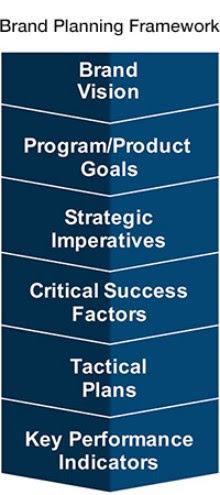Back in the Mesozoic Era, when I was coming up the marketing line (also known as the 90s), we used something called “The Mapping Approach to Strategy.” This involved propelling the team three to five years into the future and imagining how the product being developed would be positioned in the customer’s mind. Then we would define the strategic path to get there.
It was a collaborative, two-and-a-half day experience that leveraged the domain expertise of a cross-functional team: market analytics, marketing, clinical specialists, medical affairs, regulatory, and field sales. (Market access was not a thing back then.) We dove deep into both the clinical and market data — all with the goal of ensuring that we thought long-term and from the customer’s and external point of view.
We spent significant time poring over the current landscape before we started to envision the future. We defined where we are (R) today in customers’ minds and where we want to be (2B) down the road. These were essential elements of the mapping approach, as it would be on any journey.
It is not my intent to advocate for this approach as much as to highlight some of what has been lost in the “new way” of operating.
Today, many companies employ a “strategic imperatives” approach to strategy formulation. With that evolution, something has been lost (read: strategy). Not because strategic imperatives are not important, but they often don’t consider the customer perspective and frequently summarize tactical priorities rather than reflect true strategic objectives. Many times, they are neither strategic nor imperative.
Also, we find that many teams haven’t been fully trained in this model and don’t even speak a common language. This increases confusion and drives people to the comfortable land of tactics.
We have tried to provide some semblance of consistency and a shared taxonomy of terms. As the graphic to the right suggests (and as we addressed in a previous e-conversation), we recommend first elevating the thinking and in doing so, defining the brand vision.

The brand vision represents the tree on the hill, the sunrise on the horizon, the stars in the sky — a look at the impact this product could have on patients, customers and other stakeholders in the mid- to long-term. We then work our way down the strategic continuum, ultimately focusing on tactical considerations.
Strategic imperatives are an important component of the strategic process, but it is critical that teams have a shared perspective of what these represent. We define strategic imperatives as: Higher-level priorities for the brand that are necessary to address market dynamics and enable success, typically covering the 3-year timeframe. Strategic imperatives should address how the company plans to achieve its vision and goals, including overcoming product/market issues, and have a positive, active perspective.
In our experience, many teams struggle with using this framework to reflect the expansive long-term strategic thinking that is needed on the path to drug commercialization. It is fragmented, formulaic, and template-driven. It is often focused on developing tactics to drive a budgeting process.
Not unlike how social media has amped up our “communication activity” at the expense of real conversation, the commercialization process as practiced in our industry today has become frenetic and tactics-based at the expense, I fear, of real insight.
Where do we go from here?
I don’t pretend to have all the answers. And I understand all too well how much our industry has changed over the last several years, due in part to bandwidth challenges, tightened budgets, increased complexity, and the sheer number of marketing and communication tactics now available and which we feel obliged to explore.
But I do believe we need to pay particular attention to what is being lost by abbreviating or outsourcing strategy development, or, as is too often the case, skipping past strategy entirely in our endless rush to action.
The stakes are too high and our work too vital for us to view strategic brand planning as a fill-in-the-blanks exercise to be checked off as quickly as possible on the way to other things.
Do you believe people are born with the strategy gene or can strategy be taught? Reply to this email to share your thoughts — I will share my point of view next month!